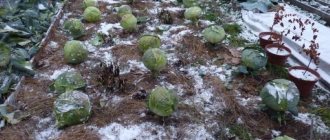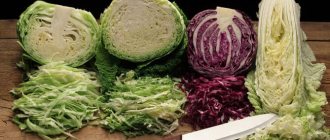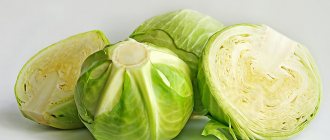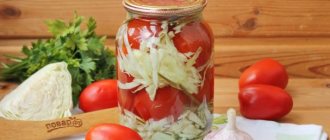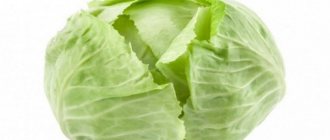Is it possible to salt or ferment
If the cabbage in the garden is frozen, can it be fermented ? When a head of cabbage has suffered from frost, it cannot be immediately taken to a warm room - such a vegetable is defrosted gradually. If properly salted, it will be tasty, sweetish, but soft. Such cabbage will no longer be crispy, but it will be quite suitable as an ingredient for borscht or cabbage soup.
If the heads of cabbage were frozen in the garden bed or balcony, they are carefully inspected. Only the top leaves may be spoiled, then the inside of the vegetable will be suitable for cooking.
Important! Once frozen heads of cabbage are suitable for pickling. If the vegetable has been frozen and thawed several times, it is not recommended to use it for sourdough. The cabbage will lose all its beneficial and flavorful properties, and the inner leaves will begin to rot.
Different opinions on pickling frozen cabbage
Different housewives' opinions on whether it is possible to ferment frozen cabbage may differ radically. Some say that frozen vegetables can no longer be used for pickling. They believe that such cabbage, if fermented, will turn out too soft and will not have a crunch. Others have a different opinion on this matter. Of course, frozen cabbage is unlikely to be crispy after salting, and it is not worth using it as an independent dish in the future. But it is quite suitable for preparing borscht, cabbage soup, and various main courses. In addition, many even in salads prefer soft rather than crispy cabbage.
Much of the suitability of such cabbage for further pickling depends on the condition of the head of cabbage after defrosting. An important point is how long the vegetable was frozen. And sometimes it happens that only the top leaves of the head of cabbage are frozen. In this case, you just need to remove them and use the rest of the cabbage for processing.
Attention! For pickling, it is possible to use heads of cabbage that have been frozen only once. If they froze and then defrosted several times, such cabbage is no longer suitable for pickling. She's getting too flabby. In addition, putrefactive processes begin to develop in it.
Recipes - how to pickle or ferment frozen cabbage
There are many recipes for fermenting frozen heads of cabbage. We offer the most popular and easy to prepare.
When using any recipe, adhere to the general rules:
- Late varieties are planted/purchased for pickling;
- choose elastic heads of cabbage, without cracks, damage and signs of rot;
- do not use iodized salt - it will soften the vegetables even more;
- Do not ferment in aluminum containers - under the influence of acid, it releases substances harmful to the body.
Housewives sometimes wonder whether cabbage needs to be specially frozen before pickling. This procedure will not improve the taste of the finished product and will negatively affect its characteristics: the cabbage will not be crispy, slippery, or soft.
Simple Ambassador
For simple salting you will need 3 kg of cabbage, 90 g of carrots and 3 tbsp. l. salt.
Cooking method:
- Heads of cabbage are being chopped.
- Grate the carrots on a coarse grater.
- Mix vegetables and add salt.
- Mash the mixture with your hands until the juice comes out.
- After the juice has been released, the vegetables are placed in jars.
- Cover with gauze and leave in a warm place for three days. The workpiece is pierced twice a day to release gases.
- Transfer the finished product to the refrigerator or cellar.
With vegetables
For sourdough with vegetables you will need:
- 1 kg of white cabbage;
- 1 kg of cucumbers;
- 1 kg of sweet pepper;
- 1 kg of tomatoes;
- 2 kg carrots;
- 1 pod of hot pepper;
- 0.5 kg of green onions;
- 6 tbsp. l. salt.
Preparation:
- Shred cabbage.
- Grate the carrots on a coarse grater.
- Cut the cucumbers lengthwise into 4 parts, and the tomatoes in half.
- Remove the seeds from hot peppers.
- Everything is mixed, salted and placed in jars.
- Press down on top with a weight and leave for a week at room temperature.
- The finished cabbage is stored in a cool place.
Spiced
You will need: 4 kg of cabbage, 120 g of carrots, cumin (to taste), bay leaf (to taste), allspice (to taste), 100 g of table salt.
How to prepare:
- Shred the heads of cabbage and add grated carrots.
- Mash the mixture, stir and add salt.
- The bottom of the dish is covered with leaves and the vegetable mixture is laid out.
- Add spices and compact tightly.
- Pressed down with a load. Make sure that the brine always covers the cabbage.
- Place the container in a warm place for 6-7 days.
- The finished product is stored in a cellar or refrigerator.
With sugar
Take 3 kg of cabbage, 90 g of carrots, 3 tbsp. l. salt and 1 tsp. Sahara.
Preparation:
- Shred the cabbage and add grated carrots.
- Mix everything, add salt and sugar. Knead the mixture with your hands.
- Transfer the mixture into jars. Press down on top with a weight and place in a warm place for three days. The preparation will have a sweet and sour taste.
Sauerkraut recipe
When everything is in order with frozen cabbage, it is pickled according to the usual recipes, like a fresh vegetable:
- whole head;
- slices, pieces of certain sizes;
- into strips, chopped with a knife.
Slightly frozen cabbage absorbs brine faster. The fermentation process accelerates. Using the accelerated method, the hostess gets her favorite dish to the table. There are many pickling recipes. The classic option is when 250 g of salt is added to 10 kg of chopped vegetables. Salting occurs in its own juice. However, a frozen vegetable does not always have enough of it. If there is not enough juice, add salted water.
When a housewife is faced with a similar problem, you shouldn’t ask everyone whether frozen cabbage can be salted, since no one will give an intelligible answer without assessing the condition of the vegetable. If frozen heads of cabbage are suitable for pickling, the finished product will be stored for no more than 2-3 months.
Storage Features
Store the preparations in a cool place: in the cellar, basement, refrigerator, on a glazed balcony. Ideally, the product is kept in wooden barrels, but few people have them, so most housewives and owners use glass or enamel containers.
The fermented product should not be stored in plastic containers for more than 3-4 days.
If the conditions are met, the shelf life of sauerkraut prepared from frozen heads of cabbage is 2-3 months.
The cabbage is frozen: how can this happen?
Any housewife can experience such a nuisance at least occasionally. Cabbage may freeze:
- in the growing bed if it was not removed in time;
- harvested or purchased for further processing if the heads of cabbage were not stored at the proper temperature.
If the cabbage is frozen in the garden, it can still be used for pickling
In addition, it sometimes happens that you can accidentally purchase a certain amount of frozen heads of cabbage. Often this fact is discovered too late, when it is no longer possible to return the vegetable to the seller.
What to do if the cabbage is frozen after harvesting from the garden
When the housewife managed to harvest the crop before frost, the heads are usually placed for temporary storage under a canopy, on a balcony or in a veranda. This is done to dry the top sheets. Such heads of cabbage last longer in storage. However, even here, an unexpected frost can damage the crop. To understand whether frozen cabbage can be salted, you need to determine the degree of freezing. To do this, the heads are left in the same place until natural thawing. You cannot bring them into a warm room.
When the frost has arrived for a long time, the heads are transferred to a cool room, but with a positive temperature. The vegetables are provided with the conditions necessary for gradual thawing. Heads of some varieties are able to restore their structure after this. They still become elastic or slightly soft.
After thawing, the heads are examined for suitability by removing several layers of foliage. Usually they freeze, but the inside remains ideal for pickling. If the freezing has occurred deeply, after removing the top sheets, cut out the stalk. The depth of damage is determined by the walls of the hole. When it is insignificant, the head can be used for pickling. When the head is completely frozen, it is discarded. Here you shouldn’t even ask whether it’s possible to salt frozen cabbage, since the disastrous result is already visible. After thawing, the leaves become flabby and fall apart in places.
If the head of cabbage is frozen. Are you here
The most important condition for good storage of white cabbage is timely harvesting of the heads in a mature state. Therefore, it is necessary to begin harvesting it only after the final formation of heads of cabbage, when they become dense. Gardeners harvest heads of mid-season cabbage in 1-2 steps from the beginning of September, and depending on the weather - until the very end of September. It’s easy to find out when this cabbage is ready for consumption. These include the size of the heads of cabbage, their density, and the appearance of a lighter shiny spot on the “top” of the head of cabbage. The appearance of this spot means that the growth and maturation of the head of cabbage has ended. Mid-season cabbage is not intended for long-term storage. It is stored for only 2-3 months. But it is better to use it for fermentation. However, until this moment it must be preserved without damage. Heads of cabbage are harvested in one go or selectively if they do not ripen at the same time. Cracked heads of cabbage are not suitable for long-term storage. The cabbage intended for pickling is removed last. After the first frost, the starch in it turns into sugar, and it ferments better. In this case, the heads of cabbage are cut down and cleared of coarse rosette leaves. Heads of cabbage intended for winter storage are left with 3-5 green leaves. Late-ripening cabbage varieties are harvested in one go at the end of the first ten days of October before the onset of constant frost -4...-5°C. If the weather permits, then there is no need to rush, since even in cold autumn weather the cabbage continues to grow intensively. When harvesting cabbage, the heads of cabbage are cut off with the stalk with a sharp, heavy knife and cleared of coarse rosette leaves. Heads of cabbage intended for winter storage must be clean, dense, whole and healthy. They are left with 3-4 green, covering, loosely adjacent leaves and a stalk 3-4 cm long, or even better, the entire stalk. It is not recommended to leave rosette leaves on these heads of cabbage, since they greatly impede air exchange in the basement after they are stacked . And heads of cabbage intended for fresh consumption are immediately cleaned to tight-fitting green leaves. Cut heads of cabbage must be immediately placed in boxes or bags. They are strictly not allowed to come into contact with the soil to avoid infection. You cannot throw cabbage, so as not to injure it with blows. It is not for nothing that the pragmatic Dutch compare harvesting cabbage to collecting eggs at a poultry farm. Under no circumstances should harvested heads of cabbage be left in the sun, as they lose a lot of moisture, wither and become unsuitable for storage. And if the heads of cabbage were harvested in the rain, then they must be thoroughly dried before storing them. The harvested heads of cabbage must be handled carefully, without bruising or damaging the leaves. Remember! If you still failed to remove the cabbage heads before severe frosts, and they froze, then you need to thaw the cabbage heads on the vine for 4-5 days to overcome the consequences of freezing, and only then remove them. In this case, such heads of cabbage will be well stored. If the plants do not “depart” after freezing, then so-called “cuffs” may appear in such heads of cabbage - a layer of dry or wet black leaves. The fact is that the inner part of the head of cabbage is most sensitive to cold and is more affected by low temperatures than the outer part. Often in areas you can see stumps sticking out of the ground, left in the ground for the winter by careless owners. This should not be done, because... they serve as an excellent wintering place for numerous cabbage pests. After harvesting the crop, you must immediately remove the stumps from the site and dig up the soil with a shovel full.
Cabbage frozen in the garden: what to do?
Many housewives often do not remove cabbage intended for pickling from the garden until the last minute. Late varieties are used for fermentation. They are cold-resistant and can withstand frosts down to -5 degrees well. The weather is often unpredictable, and you may find that the heads of cabbage freeze right on the vine.
There is no point in cutting them when they are frozen. It’s better to wait a little, because it’s possible that the next day the temperature will be above zero and the heads of cabbage will thaw. With short-term freezing on the root, usually nothing bad happens to them, and they are completely restored to their structure. And already thawed and dried cabbage can be cut, damaged leaves removed and used for further processing.
Advice. After removing cabbage from the garden that has already been frozen while standing, it is better not to delay processing the vegetable for a long time, but to ferment it immediately.
